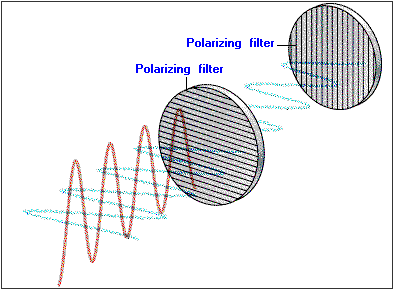
You are here: Home >> Encyclopedia of Light >> Polarization
 As we pointed out in a previous chapter when an electromagnetic wave is propagated to a direction x the electric field vevtor E is always peprendicular to axis x and the magnetic field vector B is perpendicular to both.
As we pointed out in a previous chapter when an electromagnetic wave is propagated to a direction x the electric field vevtor E is always peprendicular to axis x and the magnetic field vector B is perpendicular to both.
A beam of unpolarized light consists of waves moving in the same direction with their electric vectors pointed in random orientations about the axis of propagation. If we place a horizontal filter before the beam (in which the electic field vectors are vibrating always perpendicular and at the same time in an equal distribution of all planes), it absorbs photons whose electric vectors are vertical. If we use a second filter turned 90° to the first, it will absorbs all the remaining photons.
White light can be also polarized by reflection. However, during reflection we cannot have a satisfactory polarization. Other polarizers could be some transparent materials or crystals depending on their nature.
Surfaces like water or a highway are polarizers too. On a shiny day light waves (unpolirized light) that have the electric field vectors parallel to the surface of the road are reflected to a greater degree than those with different orientations. This type of polarization is defined as glare too. We can avoid noticing glare with sunglasses. Depending on their construction, sun glasses can absorb light waves which are vibrating parallel to the highway and let pass these light waves vibrating perpendicular to it and visa versa.
Polarization is used in many LCD (liquid crystal display) applications. Liquid Crystal, substance that behaves like both a liquid and a solid. The molecules in liquid crystals can move past each other relatively easily, much like molecules in a liquid. However, all the molecules in a liquid crystal tend to be oriented in the same manner, much like the molecular arrangement in a solid crystal. Liquid crystals retain their dual liquid and solid nature only over a certain range of temperatures and pressures.
The optical properties of a liquid crystal can often be manipulated by subjecting the liquid crystal to a magnetic or electric field that changes the orientation of its molecules. For example, by applying a small electric field, certain liquid crystal substances change from clear to murky, or gain the ability to rotate polarized light. These types of liquid crystals are used to construct displays used in digital watches, calculators, miniature television sets, portable computers, and other items. Liquid-crystal displays are sharper and often use less power than conventional displays.